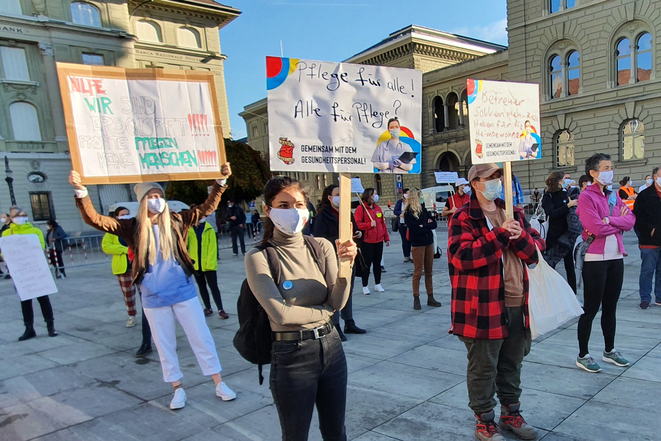Share Twitter Facebook Email Copy URL
In a recent interview, German philosopher Axel Honneth expressed what he considers to be one of the principal contradictions of contemporary societies: the absence of democracy in the workplace. According to him, a company is “another world”, founded on submission and authoritarianism, at the heart of the deliberative space of parliamentary democracies. And he was surprised that “no one is surprised” by this contradiction (Honneth 2021).
The pandemic and the measures taken by governments to curb its spread have had major impacts on this “other world”, affecting the heart of the organisation of capitalist production, and specifically remuneration (and therefore the distribution of wealth produced) and workplace health (and thus limitations concerning the exploitation of labour). As the historian Frank Snowden said so well: “Epidemics are not random events that attack societies in a capricious and unexpected manner. To the contrary, each society produces its own specific vulnerabilities.” Their study allows us to grasp, like the expression suggests, “the structure of society, its quality of life and political priorities” (Snowden 2019: 7).
The Swiss work world has revealed its “specific vulnerabilities” in a particularly virulent and rapid manner. In isolated cases, they were the object of employee mobilisations and union demands. Their analysis leads us to question democracy (Honneth) and determine the state of the social force report (Snowden).
Facing charity, struggles for social rights
The measures taken by the Swiss government have rapidly increased the number of layoffs or partially unemployed persons (RHT), reaching around 40% of the working population. The government was thus obligated to pay tens of billions of francs in public aid in the form of bank loans to companies, RHT and unemployment benefits and loss of profit to (small) independents.
Yet, not everyone benefited in the same manner from this aid. For persons with a low salary – the large majority of RHT beneficiaries -, the loss of income shifted a large number into poverty level (Tillmann et al, 2021). But most importantly, the majority of social insurance systems are based on the model of a stable contract for an indefinite period and become deficient when faced with the multiplication of precarious work situations. Tens of thousands of persons with atypical contracts or without legal status therefore fall between the cracks. Certain employees thus resorted to social assistance or, for persons without access, to distribution of food baskets (Bonvin et al., 2020).
Others chose the path of collective struggle. Particularly in Geneva, a cycle of union action took place starting in mid-March 2020, bringing together precarious employees without the right to benefits, including numerous undocumented women in the domestic economy, but also false independents (food delivery or other intermediaries). The concomitance of these mobilisations with a public opinion that was discovering the existence of extremely precarious situations led to paradoxical discourse. On the one hand, a multitude of private initiatives were launched to alleviate the food crisis. These actions “based on the humanitarian and compassion and not on social justice and equality”, according to Didier Fassin (2010: 3), allowed authorities to avoid structural handling of vulnerabilities that appeared in the local job market.
On the other hand, precarious workers involved in the struggle developed a discourse built around the notion of the right to replacement income based on previous salary. In Geneva, the unions succeeded in bringing together a large social coalition, from mutual aid projects to business associations, proposing the establishment of compensation for precarious workers, voted on by Genevan parliament and approved by the population with 68.8% of votes, that didn’t operate “within discrimination based on job or legal status” (DCS 2020: 12). In other words: in a remarkable manner, the union mobilisations in the spring of 2020 led to the establishment of a new right for precarious employees, without excluding undocumented persons. On a national level, the union pressure allowed for the integration of temporary workers into the RHT system, opened unemployment benefits to cultural intermittents and even provided 100% compensation for low salary workers.

Photo: Unia, 2020
Workplace health and union absences
The unions were much less active on the issue of workplace health. Yet numerous studies established that the exposure to the virus and comorbidities is, for persons between 20 and 65 years of age, directly linked to their professional activity[1]. People spend a large part of their day in a work environment (often closed) and in constant interaction with other colleagues or the public. Poor work conditions therefore reinforce the risk of contamination. These same populations often combine related socio-economic vulnerabilities: they cannot take time off to get tested, they do not get tested so as not to lose their income, etc.
However, in Switzerland, even the indicators that rely on professional activity and the workplace of affected persons are lacking. The only numbers available with the Federal Office of Public Health (OFSP) indicate that 8.7% of contaminations will occur at the workplace, in third place following the categories “family member” and “various” (OFSP, 2 August 2020). Obviously, there is a direct connection between the absence of socio-professional data and the desire of political authorities to avoid placing work at the centre of COVID-19 prevention. This would implicate intervention in the organisation of work and the flow of merchandise, and therefore the central process of capitalist accumulation and profitability. This is exactly what the virulent campaigns of business associations were careful to avoid in order to continue to work as long as possible.
Surely, the state intervened as a last resort, mainly due to the fear of seeing the health system collapse. But the union mobilisations, like in northern Italy, where the strikes in March 2020 forced a number of factories to close, were the exception. In Switzerland, the actions taken on workplaces were limited to several regions (Geneva, Tessin), and contributed to push a small part of the union movement to demand a solidary lockdown[2] as a way of saving human lives[3]. The major unions themselves made the choice to remain “very removed concerning the epidemiological measures (…) especially due to the fact that they do not have as much expertise as the Confederation” (USS, 2021), but also due to the fear of economic costs related to possible closures[4]. We could have expected the union movement to put pressure on the government to at least establish a right of withdrawal and increase the inspections for sanitary measures. Yet, that was not included in their priorities.
In this way, the federal authorities limited the measures of semi-confinement to industries of little added value and leisure activities. Clearly, we prohibited people from spending time outdoors during their free time, but no measure restricting the activity of businesses was taken. It was only in January 2021, when the second wave brought Switzerland into the lead in international mortality statistics, that the government decided on a telework obligation (barely monitored) and several specifications concerning the obligation to wear a mask, all while stating that “we don’t have the money to save everyone” (according to the Finance Minister Ueli Maurer). Switzerland chose a path that Annie Thébaut-Mony described as “the state and employers placing employees in general danger” (2021).
Conclusion
The (lack of) union interventions during the pandemic show(s) that it was able to channel aspirations of justice and solidarity as it broadly reinforced unfavourable power relations. Surely, it is easier to find billions to finance the loss of profits than to gain support, even very limited, for interference in capital accumulation processes in the name of public health. In effect, the protection of income greatly benefits business themselves; directly, as the public aid systems are primarily an instrument that the state substitutes for employer obligations, and indirectly, because they are reinjected into the economic circuit.
The weak measures taken to protect health in the workplace is itself directly correlated with the collective absence of organized employees in businesses. Compensating for these historical shortfalls requires a change in the paradigm on the part of major unions so that health in the workplace is considered an extremely political subject. It is a democratic requirement that is critical for these unions to start confronting.
[1] Among the few studies done in Switzerland on this subject, we mainly mention that of Stringhini et al. (2021). For a review of the international literature, cf. Purkayastha et al.
[2] Specifically, see the emergency plan of the Genevan Community of Union Action (CGAS 2020).
[3] Which various studies confirmed a posteriori: Today, the countries that followed the “zero COVID” strategy have a much better health and economic summary than the countries that chose, like Switzerland, the yo-yo strategy (Oliu-Barton et al. 2021).
[4] The Swiss Trade Union Federation announced it was against a lockdown “because the costs would be too high” (SRF, 24 October 2020). Yet, with a public debt of 25.8% of the GDP and the possibility of financing expenditures at negative interest rates, Switzerland would have easily had the means to finance a loss of profits for its working population (Dittli 2020).
Alessandro Pelizzari, Haute école de travail social et de la santé [School of Social Work and Health] Lausanne (HETSL / HES-SO).



